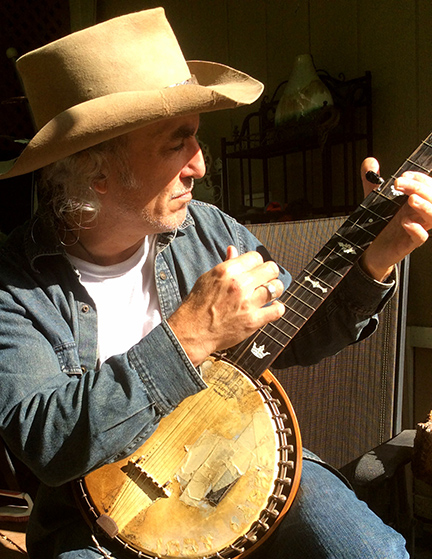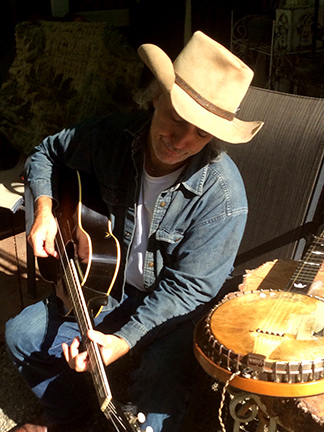by Frank Matheis 2020

It’s hard to say what’s more remarkable, the amazing talent of this Lafayette, Oregon, based singer/songwriter, or the fact that he is vastly under the radar and not nearly as well-known as he should be. He is dually a visual artist and a roots & blues musician who plays guitar and banjo, equally at home in deep roots Americana and acoustic blues. He plays Delta style, with an aggressively fiery, hard-driving, thunderously rhythmic style, accompanied by a fierce, bombastic slide. His wide repertoire is a combination of blues, Americana and roots music that covers the spectrum all the way over to Appalachian mountain music. In his sound, you hear elements of early country, folk music and blues with a diverse perspective. He goes by the stage name Jody Carroll, but inexplicably, as seen in the YouTube Video below, he sometimes goes by Joe McMurrian.
Thecountryblues.com interviewed the swift singer/songwriter/visual artist and musician via phone in Lafayette, Oregon on September 28, 2020, smack dab in the middle of the Covid-19 pandemic. It turns out he had no trouble telling his own interesting story.
JC: “I was born in Concord, in the northern part of California. My family is from Oklahoma-Texas area. Parts of my family were musicians – some of my great uncles and grandfather and father – they all played guitar. When I was growing up it infiltrated my mind over the years and eventually I got to get my own guitar, when I was maybe 11 and I worked it from there until I got up to about junior high school. At that point I joined my first rock band and played in various Bay Area hard rock bands until ’89. I was born in ’68. At that point, I was listening also to a lot of ZZ Top and Johnny Winter and the electric blues, like Buddy Guy, Stevie Ray Vaughn and all those guys. So that got me into electric and more standard blues, the city blues as they call it. That lasted until about 1990 when I was given the new release of Robert Johnson’s material. I moved down to Los Angeles to go to art school. I’ve always been a visual artist. I moved to Pasadena and then when I graduated with a BFA in illustration from the ArtCenter College of Design. I started up with some friends a mural company, and we were painting murals on hotels and casinos all around down in Mississippi. I was spending my summers in Mississippi on Highway 61 down there in Tunica painting murals on the side of these makeshift casinos they were putting up. And then it just sprung from there.
I think it was about the point – the week that Stevie Ray died. When he died, I realized there was just no point. Not much else more can be done with the electric guitar, that single-note, single-line blues stuff, the traditional city using a regular pick. I remember that I realized that none of the country blues, Delta blues artists I was passionate about used a pick – not even Lightnin’ Hopkins. I was listening to a lot of T-Bone Walker and the jazz guys. I heard the old country players like Robert Johnson, use of their fingers. I remember it was the week Stevie died that I got rid of all my electrical equipment and got myself a good guitar and just started really learning finger style and slide.
It was some type of Harmony – regular size not a Dreadnought. I wish I still had it. I got real sick actually that year. I was in the hospital with toxic shock blood poisoning and I almost died. I couldn’t draw, for instance. I was really drawing and painting a lot as an artist, so I couldn’t do that. I also couldn’t hold the pick or anything very well, so I remember I started listening to slide players at that point and started playing on my lap. I was in the hospital and it just got me into that slide world.
I was an illustrator at Disney at the time in Glendale. I was working near McCabe’s guitar shop in Santa Monica, so I’d go in there on my lunch hours and then I got a recording of the Newport Folk Festivals from ’64-65. That’s what blew it out of the water for me. It was like a religious experience. I heard Son House that day for the first time and I was on my lunch and I didn’t go back to work that day. I spent the rest of my time trying to find any information. I had to send away to Grossman’s shop to get a video and see them. That’s all I did for the next whatever amount of years until I left LA and moved up to Oregon. I left LA and came up here to go to grad school and got my master’s in fine art painting at Portland State University. Then I started teaching there – for about 7 years I taught at Portland State and Pacific Northwest College of Art, Oregon State University. I was jumping around all that and doing my gigs all around. But I quit that.
I quit teaching to really devote everything to music and art in itself. I’m not opposed to doing it again. I just started traveling. I’ve been traveling the country for the last six years in a motor home nonstop.
I come from being a visual artist, so I think my attitude and training there applies to how I approach music. I don’t want to be pigeonholed, but I also got to a point of studying the traditions enough that I can play them if I want to, but it’s like copying a Van Gogh painting – there’s no use – it’s been created once; there’s no use in doing it again.
Musicians sometimes fall into the trap of traditionalism and really sticking to the record. I don’t follow that. I just try to absorb as much of it as I can. It’s a potpourri –, it’s a gumbo. As much Delta blues as there is hillbilly music is in there. I come from a rock background so I want some energy and power in there that – and then it’s all about song. I just got to a point as a songwriter and as a storyteller and a picture maker, which is really what I aspire to be. The song is like a sketch painting, but more impressionistic. I’m trying to play my guitar like I love to, which is hard and aggressive but I’m also trying to get some song material in there with a concise story or thought or impression. I think to do that properly I have to be willing to pull in as many colors as I can. I play the banjo for instance. I’ve been living in the Southern mountains of America and a lot of that picking came from there. That’s the trajectory of the styles that we hear, the sounds we hear out on the Delta, for instance, are interpretations of mountain music really. It came out of the southern Appalachian range, into Tennessee, eventually into Mississippi. That brought me from the Delta up into the Blue Ridge of America. So that’s why I try to – I mean I’m really trying to present something that’s traditional yet progressive enough to be current.
Songwriting is a wonderful, amazing thing, once you learn how to do it and allow yourself to have fun with it. It’s a very painful thing. It doesn’t come easy. It’s a weird sort of pain and pleasure experience when you get deep into it. But when you start really listening to songwriters – I can sing any number of Charley Patton, Son House, Skip James or Robert Pete songs, but you know as songs go, in terms of a song, like if you play me a Townes Van Zandt song or something – that’s real songwriting – Dylan and all that. It’s real songwriting. To me that just means that the poetics of the words have been analyzed and designed in a certain way. It’s not always about emotion.
Songwriting, for instance, trying to hold yourself up to the bar of what’s come before you – really being honest with yourself. You can’t do that unless you studied and listened to a lot of them. For songwriters, I love Townes Van Zandt, Blaze Foley, Dylan –anything like that – Guy Clark. Everybody wants a song that either communicates your point of view in life; or, something that happened to you so that somebody else can enjoy that. But how do you do that? You can’t just say it verbatim – that’s pretty boring. The only person who could really do that was Woody Guthrie – he’d just sing the facts – a lot of times he would just look at a newspaper and got to write a really cool little diddy and tell a story of what happened. That’s a lot of the way it used to be – and that’s wonderful. But a lot of his songs are not just that. They’re very emotional in content and poetic. I strive for that.
I’m playing the festival circuit and smaller clubs basically – performance theaters – I had a show a couple days ago here in town in Portland. I keep a band here in Portland. Two of my albums have band work on them. And with them we have a studio release with Yellow Dog Records out of Memphis.”

